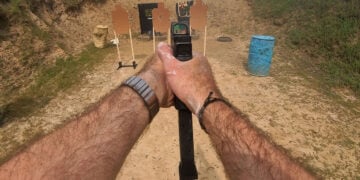Unless you live under a rock (and probably a really big one), you have likely heard of Active Self Protection or John Correia. John runs one of the most successful self-defense and firearms-centric YouTube channels that I am aware of. He also teaches classes on the side, basically.
Active Self Protection just happened to be a couple of hours down the road from me for one of their pistol classes, and tacked on a 1-day shotgun class following. I am the shotgun guy, so I certainly couldn’t miss that opportunity to see what the YouTube star had to say about shotguns. I loaded the battle wagon at 5 am on a Monday and hit the road to Old Fort Gun Club in Fort Smith, AR.
The Old Fort Gun Club
This was my first trip to Old Fort Gun Club. The facility is top-notch. Several bays are arranged in rows around the property, with covered areas on each range. The bays all seemed to be 30-ish yards deep and about 20 yards wide. If I lived around Fort Smith, this would definitely be my club of choice.
In The Classroom
The class started at 9 am in the classroom. Quick intro’s from John and his right-hand man Neil Weidner, and a quick trip around the classroom for everyone to introduce themselves and give some background. I typically try to fly under the radar and left out that I write on the internet about shotguns. John made sure to call me out though, so my cover was blown, and the pressure was on.
While I appreciate the time spent on the range shooting drills, I find these days that I usually get just as much, if not more, value out of the classroom portion of a class. The ASP shotgun class wasn’t any different. Seeing and understanding John and Neil’s focus for the rest of the class really set the tone. They essentially applied the Pareto Principle to the shotgun and used this to drive the direction of everything else going forward. What is the 20% that gives the most value?
The $1,000 Gunfight
One of my favorite parts in the classroom was what I have termed “The $1,000 Gunfight”. The point being made by the story is that we really need to understand what is at stake when we place ourselves in a circumstance. Many times the only thing on the line is money, in many cases, an insurance deductible (the $1,000). In those instances, we should do our best to keep ourselves out of it and let the qualified immunity crowd (read: police) handle it. The cost of getting ourselves into a fight can be unbelievably high, in both material cost and emotional/mental costs. Don’t get in fights over property, ego, or anything else short of life-saving.
The Part of Class Behind the Gun
On the range, the class started with a quick overview of some techniques and then a skill assessment. In general, most of the people in the class were very new to defensive shotgunning. This came out during the assessment, which I think was the point. It was a marker for everyone to know where they started from. While having the assessment early in the class bogged the pace down a bit, I think there was a big payoff at the end. We will get to that soon.
The live fire progression of the class was logical and fairly quick. Topics were discussed, demonstrated, and then repped by the class, which was split into two relays. Usually, the class got 5-10 reps of a skill before moving to the next thing.
As the class progressed, some skills were layered over the top of another. For example, the first live-fire drills were focused on recoil management. Every live fire drill following, recoil management was still being worked on even though there were relatively few reps focused only on recoil management.
Ending Assessment
The final part of the live fire class was another swing at the assessment used at the beginning of class. John and Neil were set up on opposite sides of the range and would take turns running a single person through the assessment. This showed students how much they had improved, and I think the hope is to encourage continuing development.
While I was standing back and watching the other students run through their assessments, I made notes mostly of John and Neil. At the end of each person’s turn, they would shout across the range to each other, pointing out where the person improved and by how much. Even if it wasn’t that big of an improvement, they made a big deal out of it. This makes the student feel really good. Like they accomplished something worthwhile (because they did). I could see their desire for people to feel good about themselves and what they accomplished.
The Big Picture
So what is the final take? Where does ASP’s Evidence Based Shotgun Skills fit in the larger marketplace of shotgun classes? This is a fast-paced 1-day class that covers a lot of ground in not a lot of time. It skims the tops of the waves on most things and focuses hard on a couple of key points. Primarily centered around controlling the gun.
I saw new shotgunners leave the class, having made some substantial leaps forward in their approach to the gun. I came away with an improved understanding of a couple of key principles and stance corrections that helped build some new speed. This tells me the class can hit the gamut of shooters from beginner to pretty good and give everyone something worthwhile to chew on.









